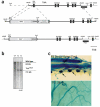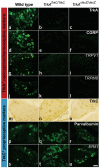Expressing TrkC from the TrkA locus causes a subset of dorsal root ganglia neurons to switch fate
- PMID: 15247919
- PMCID: PMC2693051
- DOI: 10.1038/nn1283
Expressing TrkC from the TrkA locus causes a subset of dorsal root ganglia neurons to switch fate
Abstract
Tactile information is perceived by a heterogeneous population of specialized neurons. Neurotrophin receptors (the receptor tyrosine kinases, Trks) mark the major classes of these sensory neurons: TrkA is expressed in neurons that sense temperature and noxious stimuli, and TrkC is expressed in proprioceptive neurons that sense body position. Neurotrophin signaling through these receptors is required for cell survival. To test whether neurotrophins have an instructive role in sensory specification, we expressed rat TrkC from the TrkA (also known as Ntrk1) locus in mice. The surviving presumptive TrkA-expressing neurons adopted a proprioceptive phenotype, indicating that neurotrophin signaling can specify sensory neuron subtypes.
Figures





References
-
- Scott SA. Sensory Neurons: Diversity, Development, and Plasticity. Oxford Univ. Press; New York: 1992.
-
- Patapoutian A, Reichardt LF. Trk receptors: mediators of neurotrophin action. Curr. Opin. Neurobiol. 2001;11:272–280. - PubMed
-
- Markus A, Patel TD, Snider WD. Neurotrophic factors and axonal growth. Curr. Opin. Neurobiol. 2002;12:523–531. - PubMed
-
- Gundersen RW, Barrett JN. Neuronal chemotaxis: chick dorsal-root axons turn toward high concentrations of nerve growth factor. Science. 1979;206:1079–1080. - PubMed
Publication types
MeSH terms
Substances
Associated data
- Actions
- Actions
Grants and funding
LinkOut - more resources
Full Text Sources
Other Literature Sources
Molecular Biology Databases
Research Materials

